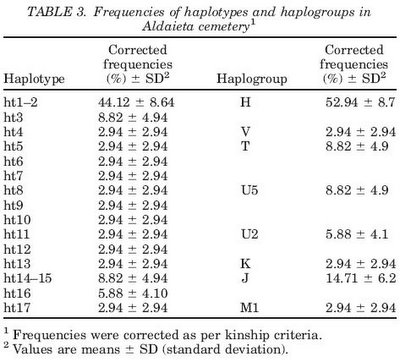
And an exciting hint at future developments in ancient DNA:
Furthermore, two individuals in a group burial in the SE revealed the existence of a mutation in the Y chromosome (haplogroup R1b3b; unpublished data), considered to originate in the Basque Country, where it now presents the highest frequency in Europe (7.1%, as opposed to 0.9% in the Iberian Peninsula; Alonso et al., 2005).
Am J Phys Anthropol. 2006 Jan 19; [Epub ahead of print]
Insights into the "isolation" of the Basques: mtDNA lineages from the historical site of Aldaieta (6th-7th centuries AD).
Alzualde A, Izagirre N, Alonso S, Alonso A, Albarran C, Azkarate A, de la Rua C.
We analyzed the hypervariable region I (HVR-I) sequence variability of the mitochondrial DNA (mtDNA) of individuals buried at Aldaieta (6th-7th centuries AD) in order to find out more about the biosocial implications of this cemetery. The results, fully authenticated by means of diverse criteria (analysis of duplicates, replication in an independent laboratory, quantification of target DNA, and sequencing and cloning of polymerase chain reaction products), suggest that Aldaieta largely consists of autochthonous individuals who shared common funereal customs with the late Ancient North Pyrenean cemeteries of Western Europe (the Reihengraberfelder), a cultural influence possibly accompanied by a certain genetic flow. Furthermore, the distribution of mtDNA lineages in the cemetery highlighted the existence of a significant number of family relationships, supporting the belief that it was a stable settlement and not a group that had haphazardly settled in the area. Finally, this paper stresses the importance of ancient DNA data for reconstructing the biological history of human populations, rendering it possible to verify certain hypotheses based solely on current population data. The presence at Aldaieta of an mtDNA lineage originating in Northwest Africa testifies to the existence of contact between the Iberian Peninsula and Northwest Africa prior to the Moorish occupation. Both this latter discovery and the high frequency of haplogroup J at the Aldaieta cemetery raise questions about the generally accepted belief that, since ancient times, the influence of other human groups has been very scarce in the Basque Country.
Link

No comments:
Post a Comment